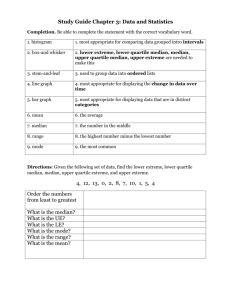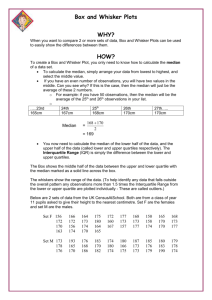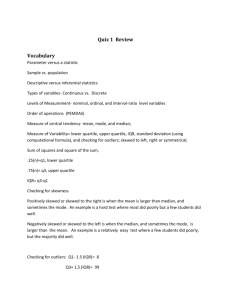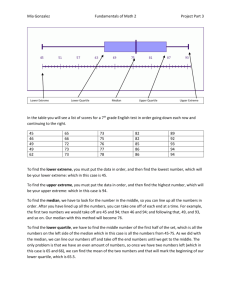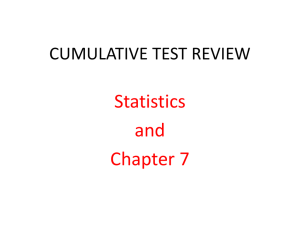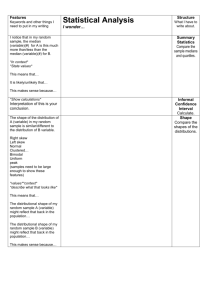File
advertisement
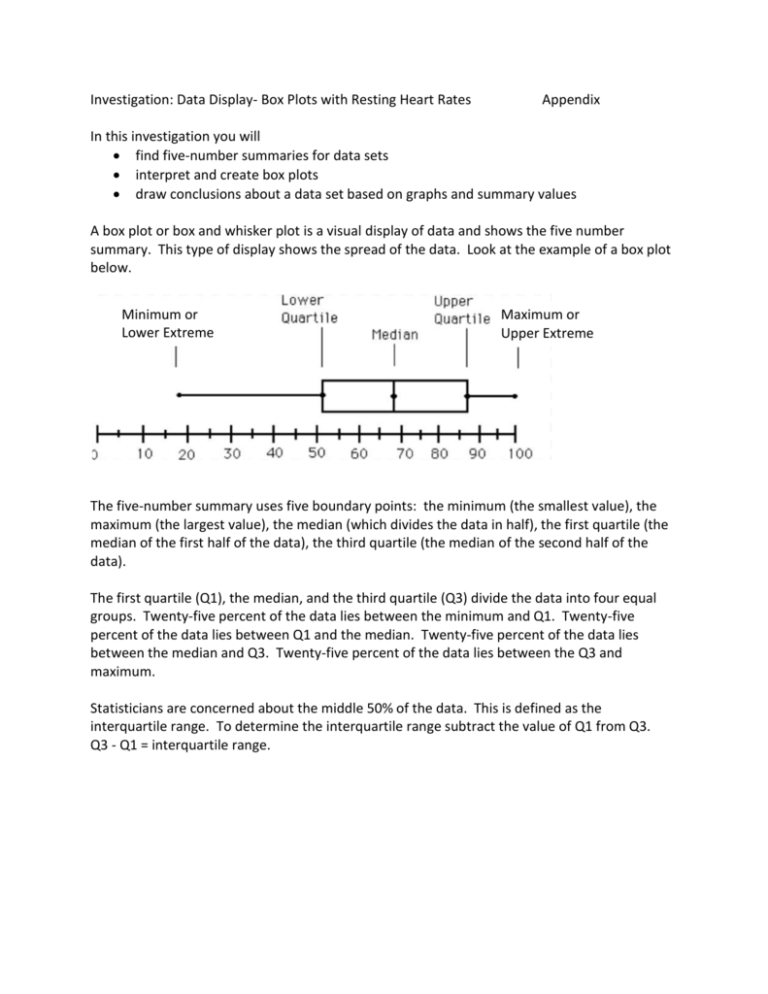
Investigation: Data Display- Box Plots with Resting Heart Rates Appendix In this investigation you will find five-number summaries for data sets interpret and create box plots draw conclusions about a data set based on graphs and summary values A box plot or box and whisker plot is a visual display of data and shows the five number summary. This type of display shows the spread of the data. Look at the example of a box plot below. Minimum or Lower Extreme Maximum or Upper Extreme The five-number summary uses five boundary points: the minimum (the smallest value), the maximum (the largest value), the median (which divides the data in half), the first quartile (the median of the first half of the data), the third quartile (the median of the second half of the data). The first quartile (Q1), the median, and the third quartile (Q3) divide the data into four equal groups. Twenty-five percent of the data lies between the minimum and Q1. Twenty-five percent of the data lies between Q1 and the median. Twenty-five percent of the data lies between the median and Q3. Twenty-five percent of the data lies between the Q3 and maximum. Statisticians are concerned about the middle 50% of the data. This is defined as the interquartile range. To determine the interquartile range subtract the value of Q1 from Q3. Q3 - Q1 = interquartile range. Step 1: Record the resting heart rate for every student in the class. Student 1 _____ Student 2 _____ Student 3 _____ Student 4 _____ Student 5 _____ Student 6 _____ Student 7 _____ Student 8 _____ Student 9 _____ Student 10 _____ Student 11 _____ Student 12 _____ Student 13 _____ Student 14 _____ Student 15 _____ Student 16 _____ Student 17 _____ Student 18 _____ Student 19 _____ Student 20 _____ Student 21 _____ Student 22 _____ Student 23 _____ Student 24 _____ Student 25 _____ Student 26 _____ Student 27 _____ Student 28 _____ Step 2: Put the data in order from smallest to largest. Indentify the lowest pulse rate. This value is the minimum or lower extreme. Minimum: ___________ Indentify the highest pulse rate. This value is the maximum or upper extreme. Maximum: ____________ Step 3: Determine the median. The median is the middle value in your list of numbers. It divides the data into two halves. If you have an odd number of students in your class, then the median is an actual point or value. If you have an even number of students in the class, the median is the average of the two middle values in your data. The formula for the place to find the median is "([the number of data points] + 1) ÷ 2", but you don't have to use this formula. You can just count in from both ends of the list until you meet in the middle, if you prefer. Either way will work. Median: ____________ Step 4: Now you will determine Q1 and Q3. The median divides your data into two halves. Quartile 1 is the median of the lower half of your data. Note: If the median falls between two data points, then the lower point is considered part of the lower half of the data and the upper point is part of the upper half of the data. Q1:____________ Determine Q3 by determining the median of the upper half of the data. Q3____________ Page 3 Appendix Step 5: Construct a box plot using your data. Use a clean sheet of paper to draw a number line with a consistent scale. The number line should start below the minimum and extend past the maximum. Find the median value on your number line and draw a short vertical line segment just above it. Repeat this process for the first and third quartile. Place dots above your number line to represent the minimum and maximum values. Draw a rectangle with ends at the first and third quartiles. This is the box. Draw horizontal segments that extend from each end of the box to the minimum and maximum values. These are called the whiskers. The difference between the first quartile and third quartile is the interquartile range, or IQR. Like the range, the interquartile range helps describe the spread of the data. Step 6: Answer the questions below. a. b. What are the range and IQR of your data? How many pulse rates fall between the first and third quartiles of the graph? What fraction and percentage of the total number of pulse rates is this number? Will this fraction and percentage always be the same? Data that are more than 1.5 times the interquartile range beyond the quartiles are called outliers. First determine the IQR IQR - 1.5(Q1) will determine the outliers for the lower part of the data. IQR + 1.5(Q3) will determine the outlier for the upper part of the data. Outliers are not connected to the whiskers. Step 7: Determine if any outliers exist in the data. Interpret what this would mean for our data set.

